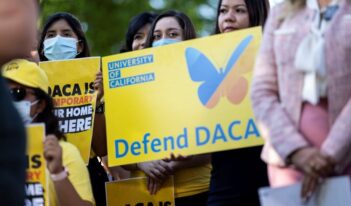
Scholars explore how barriers to public benefits impact noncitizens’ well-being.
As a presidential candidate in 1991, Bill Clinton promised to “end welfare as we know it.” Five years later, in 1996, President Clinton signed the Personal Responsibility and Work Opportunity Reconciliation Act into law.
The 1996 welfare reform law overhauled the federal social safety net. Welfare experts often focus on the creation of the Temporary Assistance for Needy Families (TANF) program and the end of cash assistance as a guaranteed public benefit for income-eligible families. Among other controversial reforms, TANF allowed states to decide how to spend their allocated federal welfare funds and imposed work requirements on beneficiaries.
But welfare reform introduced changes beyond TANF. Immigration and welfare policy experts point out that the 1996 law also overhauled nearly every aspect of noncitizen eligibility for public benefits, including and beyond federal cash assistance—impacting noncitizens’ health and well-being for years to come.
With some exceptions, noncitizens who entered the United States after the enactment of welfare reform in August 1996 became ineligible for most income-based welfare, health insurance, and cash assistance programs within the first five years of their arrival. Such programs include TANF, Medicaid, and Supplemental Security Income.
In addition, welfare reform created two categories of immigrants for welfare eligibility purposes: “qualified” and “not qualified.” “Qualified” immigrants include certain noncitizens legally permitted to stay in the United States, such as legal permanent residents and refugees. “Not qualified” immigrants include undocumented individuals, but also many noncitizens who are considered lawfully present.
During welfare reform negotiations, many lawmakers opposed public benefits for noncitizens altogether. They noted that federal laws dating back to 1882 permitted immigration officials to deny entry to immigrants they believed would become “public charges,” or financial burdens on the government through their anticipated welfare use.
Immigration scholars observe that the Trump Administration reinvigorated similar sentiments when it introduced a new public charge rule in 2019 that made certain noncitizens ineligible for legal permanent residency or entry into the United States if they used public benefits. These scholars note that President Donald J. Trump’s rule broadened the definition of public charge to include immigrants who received benefits such as Medicaid and food, energy, or housing assistance for more than 12 months within a 36-month period.
Scholars from the Migration Policy Institute contrast this development with the old public charge rule from 1999, under which noncitizens would become a public charge only if they received cash assistance, such as TANF benefits, or used long-term institutional care services, such as nursing homes, at government expense.
President Joseph R. Biden has since replaced former President Trump’s public charge rule with one that resembles the 1999 policy. Despite the change, confusion about the public charge rule persists, as some public health experts note that many immigrants are still worried about the possible immigration consequences of using public benefits.
Although some public officials maintain that immigrants drain welfare resources, economic researchers have found that immigrants generally consume fewer welfare and public benefits than native-born Americans. Indeed, immigration researchers note that low-income immigrants are less likely to access benefits compared to their low-income, native-born counterparts.
In this week’s Saturday Seminar, scholars examine how barriers to public benefits impact noncitizens’ health and well-being.
- From 2015 to 2020, the Trump Administration’s anti-immigrant rhetoric and public charge rule undermined immigrants’ health outcomes and compromised medical providers’ efforts to care for immigrant patients, argues Meredith Van Natta of the University of California Merced in an article in Law & Society Review. Drawing on interviews with safety-net clinic workers and patients, Van Natta finds that President Trump’s public charge rule led many noncitizens and mixed-status families to avoid seeking health and welfare benefits for fear of triggering immigration consequences, even in instances where they were legally eligible for those services. Van Natta notes that immigrant patients also negotiated the potential risks and benefits of accessing public services and health care amid challenging political environments.
- Federal laws barred nearly 1 million income-eligible immigrant children from accessing Medicaid or the Children’s Health Insurance Program (CHIP) in 2019 due to their immigration status, explains Valerie Lacarte of Migration Policy Institute in a policy brief. Despite these barriers, Lacarte notes that most states have used federal funds to expand Medicaid and CHIP coverage to more undocumented children through the CHIP Reauthorization Act. Lacarte finds, however, that low-income immigrant children across racial and ethnic groups are still more likely to be uninsured than similarly situated U.S.-born children. Lacarte attributes this difference to confusion around Medicaid and CHIP eligibility rules, language barriers, and difficulties navigating federal agencies and health care providers.
- The exclusion of undocumented immigrants from federal public benefits leaves these communities without adequate support after natural disasters, argues recent University of Baltimore School of Law graduate Faith Zellman Khan in an article in the University of Baltimore Law Review. Khan notes that about 41 percent of the noncitizen population is undocumented. As the severity and frequency of climate disasters increase, she recommends that the federal government build resilience at all levels of society. Khan contends that preventing undocumented immigrants from accessing federal welfare programs undermines U.S. economic interests. She maintains that addressing the vulnerability of undocumented immigrants in the context of disaster relief should be a national priority.
- Immigration enforcement priorities often eclipse health policy priorities when those issues intersect, argues Medha Makhlouf of Penn State Dickinson Law in an article in the Boston University Law Review. Makhlouf explains that when Congress delegates authority to the U.S. Department of Homeland Security and the U.S. Department of Health and Human Services (HHS) over issues at the intersection of immigration and health policy, it does so to leverage these agencies’ expertise. But Makhlouf finds that HHS has abdicated its health and welfare responsibilities repeatedly, especially concerning noncitizens’ health care access. She contends that political influences favoring immigration enforcement may help the Department of Homeland Security co-opt HHS’s mission and recommends that policymakers reframe health security as essential to national security.
- In an article in the Yale Law & Policy Review, Veronica Tobar Thronson of Michigan State University College of Law recommends reforming the enforcement of affidavits of support to ensure that victims of domestic violence will not be pressured to sponsor their abusers financially. Affidavits of support ensure that a prospective immigrant will be supported financially by a U.S. citizen or legal permanent resident and will not become a public charge. Thronson argues, however, that such an arrangement may compromise the financial and physical health of domestic violence victims who feel compelled to sponsor their noncitizen abusers for fear that their abusers will suffer adverse immigration consequences.
- In a briefing paper, the CATO Institute’s Alex Nowrasteh and data scientist Michael Howard find that immigrants consume fewer income-based welfare benefits per capita than native-born Americans. The authors explain that between 2016 and 2019, immigrants’ consumption of welfare relative to native-born Americans decreased by 7 percent. Nowrasteh and Howard acknowledge that immigrants tend to use the Special Supplemental Nutrition Program for Women, Infants, and Children and Medicaid at higher rates than native-born Americans, but they also note that more immigrant populations qualify for those programs. Nowrasteh and Howard contend that immigrants’ welfare usage must be assessed at the individual level, not the household level, to be measured accurately, since some households contain a mix of immigrants and nonimmigrants.
The Saturday Seminar is a weekly feature that aims to put into written form the kind of content that would be conveyed in a live seminar involving regulatory experts. Each week, The Regulatory Review publishes a brief overview of a selected regulatory topic and then distills recent research and scholarly writing on that topic.



